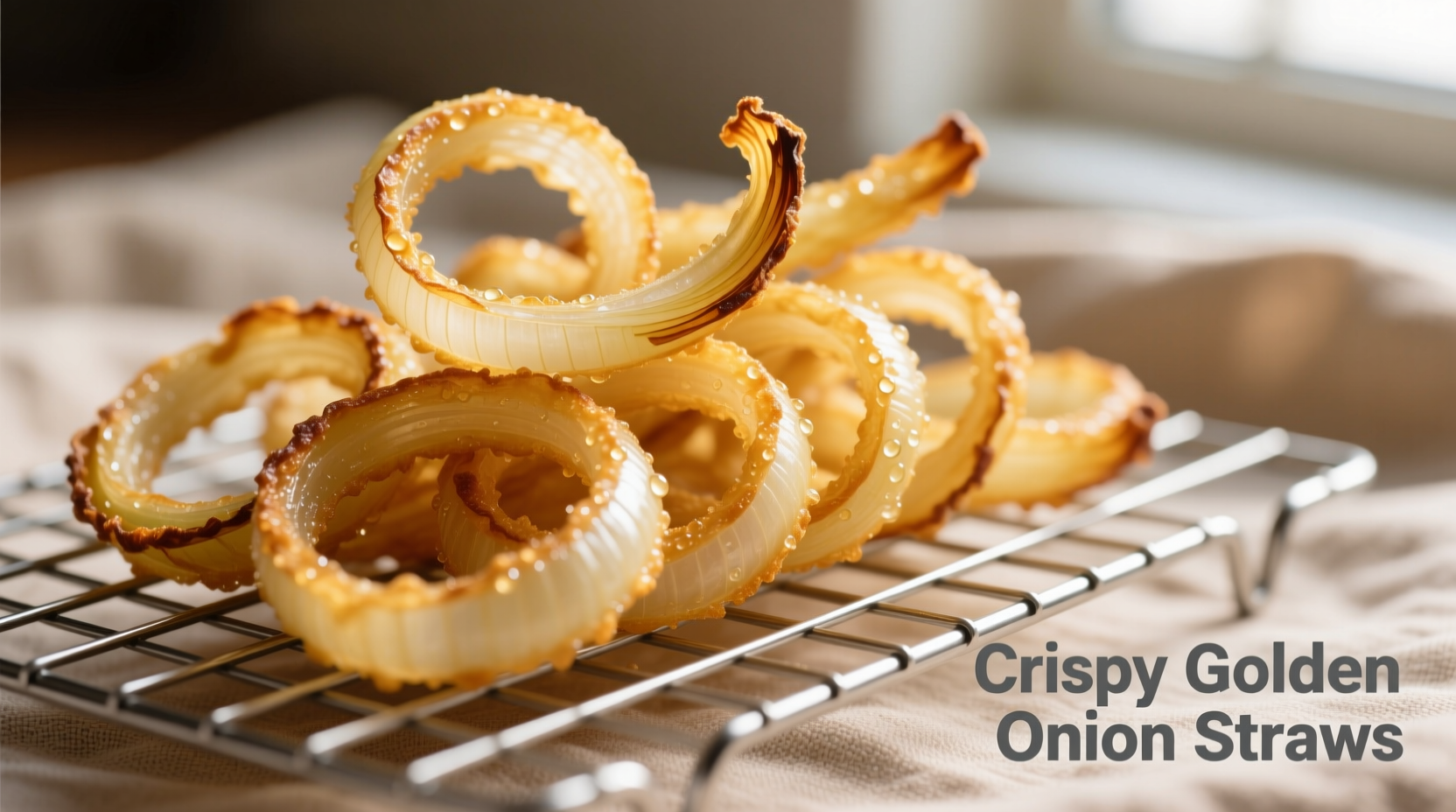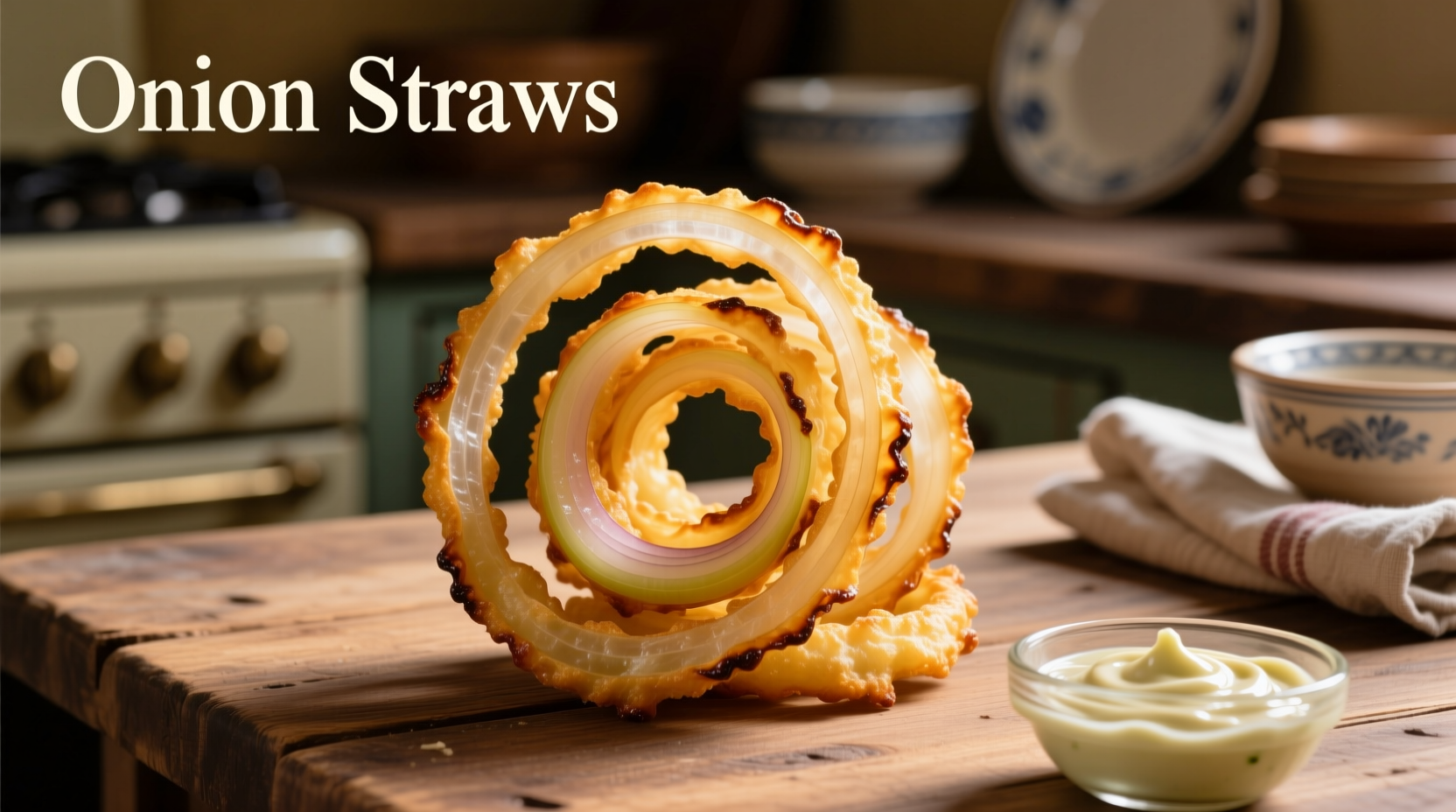When you're looking for that perfect crispy onion topping for salads, burgers, or baked potatoes, onion straws deliver a refined crunch that transforms ordinary dishes into restaurant-quality creations. Unlike their ring-shaped counterparts, these slender strands cook faster, absorb less oil, and provide more surface area for seasoning—making them the professional chef's secret weapon for adding texture without overwhelming flavor.
What Exactly Are Onion Straws?
Onion straws represent a specific preparation method where onions are cut into uniform, thin strips rather than the circular slices used for traditional onion rings. This culinary technique creates several distinct advantages:
- Consistent 1/8-inch thickness ensures even cooking
- Increased surface-to-volume ratio enhances crispiness
- Shorter cooking time (2-3 minutes vs 4-5 for rings)
- Less oil absorption (up to 30% less than rings)
- More versatile application as garnishes or mix-ins
Professional kitchens favor onion straws for their ability to maintain crispness longer than rings, especially when used as toppings for soups, salads, and main dishes. The slender shape allows them to integrate seamlessly into dishes without dominating texture or flavor profiles.
| Feature | Onion Straws | Traditional Onion Rings |
|---|---|---|
| Cut Style | Matchstick strips (1/8" x 2-3") | Circular slices (1/4-1/2" thick) |
| Cooking Time | 2-3 minutes | 4-5 minutes |
| Oil Absorption | 15-18% of weight | 22-25% of weight |
| Texture Profile | Crisp throughout | Soft interior, crispy exterior |
| Primary Use | Garnish, topping, mix-in | Standalone side dish |
The Culinary Science Behind the Perfect Onion Straw
Understanding the food science behind onion straws explains why they outperform rings in certain applications. When onions are cut into thin straws, the increased surface area allows for more efficient moisture evaporation during frying. According to research from the Culinary Institute of America, this rapid moisture loss creates a crispier texture while preserving more of the onion's natural sweetness.
The Maillard reaction—the chemical process responsible for browning and flavor development—occurs more uniformly across the entire surface of onion straws compared to rings. This results in a more consistent flavor profile without the soft, undercooked center sometimes found in thicker onion rings.
How to Make Professional-Quality Onion Straws at Home
Creating perfect onion straws requires attention to three critical factors: onion selection, batter composition, and frying technique.
Choosing the Right Onions
Sweet varieties like Vidalia or Walla Walla work best for onion straws due to their lower sulfur content and higher sugar concentration. These onions:
- Produce less tear-inducing fumes during preparation
- Caramelize more evenly during frying
- Deliver a milder, sweeter final flavor
- Hold their shape better during cooking
Perfect Batter Formula
The ideal batter for onion straws balances crispness with structural integrity. Professional chefs typically use a combination of:
- 70% all-purpose flour
- 20% rice flour (for extra crispness)
- 10% cornstarch (to prevent sogginess)
- 1 teaspoon baking powder per cup of flour
- Ice-cold water or beer for liquid
The key is maintaining a thin, pourable consistency that coats the onions without creating a heavy batter shell. As Antonio Rodriguez explains, "The batter should cling to the onions like a light veil, not a heavy coat—that's what creates that delicate, shatter-crisp texture professional kitchens achieve."
Frying Technique for Maximum Crispness
Temperature control proves critical when frying onion straws. Follow these professional guidelines:
- Oil temperature: 350-360°F (175-180°C)
- Fry in small batches to maintain temperature
- Cook for 2-3 minutes until golden
- Drain on wire racks, not paper towels
- Season immediately after frying

Creative Culinary Applications Beyond the Obvious
While onion straws excel as burger toppings, their culinary versatility extends far beyond:
- Salad Enhancer: Adds textural contrast to delicate greens without weighing them down
- Flavor Base: Cooks into sauces and soups faster than raw onions, providing immediate flavor
- Baking Mix-in: Incorporates seamlessly into cornbread, biscuits, and savory muffins
- Cocktail Garnish: Elevates bloody marys and other savory cocktails with visual appeal
- Crunchy Coating: Creates an alternative to breadcrumbs for proteins
Nutritional Profile and Health Considerations
According to USDA FoodData Central, a 1-ounce (28g) serving of commercially prepared fried onion straws contains:
- Calories: 130
- Total Fat: 6g
- Saturated Fat: 0.5g
- Sodium: 290mg
- Carbohydrates: 18g
- Dietary Fiber: 1g
- Sugars: 1g
- Protein: 2g
When prepared at home with minimal oil, onion straws can reduce fat content by up to 40% compared to commercial versions. Baking instead of frying creates an even healthier alternative while maintaining much of the desirable crisp texture.
Where to Find Quality Onion Straws
While many grocery stores carry pre-made onion straws in the canned vegetable aisle, discerning cooks know that quality varies significantly. Look for products with:
- Minimal ingredients (onions, oil, flour, salt)
- No artificial preservatives
- Uniform straw size
- Light golden color (indicates proper frying temperature)
For the freshest option, specialty food stores and farmers markets often carry locally made versions with superior texture and flavor. When selecting frozen varieties, check for minimal ice crystals, which indicate proper freezing techniques that preserve texture.
Preserving Your Homemade Onion Straws
Proper storage extends the shelf life of homemade onion straws significantly:
- Air-tight container at room temperature: 3-5 days
- Freezer in vacuum-sealed bag: 2-3 months
- Re-crisping method: 30 seconds in 350°F oven or air fryer
The key to maintaining crispness is complete cooling before storage and avoiding moisture exposure. Professional chefs recommend adding a silica gel packet to storage containers to absorb any residual moisture that might develop.











 浙公网安备
33010002000092号
浙公网安备
33010002000092号 浙B2-20120091-4
浙B2-20120091-4